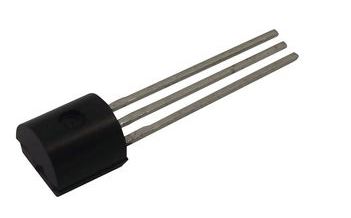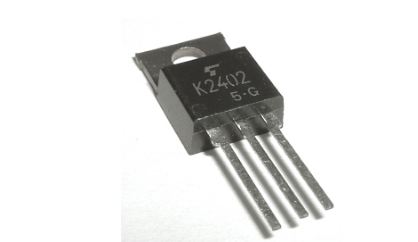A transistor is a linear semiconductor device that controls current with the application of a lower-power electrical signal. Transistors are usually categorized into two groups: bipolar and field-effect.
A bipolar transistor is a commonly used for amplification. The device can amplify analog or digital signals. It can also switch DC or function as an oscillator. Physically, a bipolar transistor amplifies current, but it can be connected in circuits designed to amplify voltage or power.
The field–effect transistor (FET) is a type of transistor which uses an electric field to control the flow of current. FETs are devices with three terminals: source, gate, and drain.
JFET/JUGFET Transistor

JFET (Junction field-effect transistor) also referred to as JUGFET, is one of the simplest types of field-effect transistor. JFETs are three-terminal semiconductor devices that can be used as electronically-controlled switches, amplifiers or voltage-controlled resistors.
Typically, field-effect transistor is composed of a silicon section whose conductance is controlled by an electric field. The section of silicon through which current flows is referred to as channel and is made up of one type of silicon either p-type or n-type. The connections at either end of the device are referred to as the source and drain. The electric field to control the current is applied to a third electrode referred to as gate, because it is the only electric field controlling the current flowing in the channel. Therefore, the JFET is a voltage controlled device with a high input impedance usually megohms.
Junction field effect transistor, JFET is a very useful active device and in this regard, they are used in many electronic circuit designs, due to some of the advantages they are able to display. The advantages include low noise, high input impedance and simple biasing among others. JFETs are used as:
- High impedance wide band amplifiers.
- An electronic switch
- Buffer amplifiers
- Voltage variable resistors (VVR) or voltage development resistor (VDR).
- Phase shift oscillator
- Constant current source
What You Need To Know about JFET Transistors
- JFET stands for Junction Field Effect Transistor.
- It is the simplest type of field effect transistor in which the current can either pass from source to drain or drain to source. JFET uses the voltage applied to the gate terminal to control the current flowing through the channel between the drain and source terminals which results in output current being proportional to the input voltage.
- JFETs can only be operated in the depletion mode because of reverse biasing of its pn-junction.
- JFETs have input impedance of (~10^8 Ω) which is very much lower than that of MOSFETs.
- JFETs are less susceptible to electrostatic discharge because they offer higher input capacitance than MOSFETs.
- The gate leakage current of JFET is of the order of nanoAMPs (10^-9 A).
- Usually, the drain resistance of JFETs is higher than that of MOSFETs, therefore the output characteristics tend to be flatter than the MOSFET.
- JFETs have been in use for a longer period of time and therefore they have slowly been replaced in many of its original use cases by more modern devices like the CMOS OpAmp.
- JFETs are simpler to fabricate and thus they are very much available and cheaper in cost.
- JFETs are perfect for use in low noise applications such as electronic switches, buffer amplifiers etc.
MOSFET Transistor

The metal oxide semiconductor field-effect transistor (MOSFET), also referred to as the metal oxide silicon transistor, is a type of field effect transistor that has an insulated gate and is fabricated by controlled oxidation of a semiconductor, typically silicon. MOSFET is the most common semiconductor device in digital and analog circuits, and the most common power device used for switching and amplifying signals in the electronic devices.
The MOSFET is a four terminal device with sources (S), gates (G), drain (D) and body (B) terminals. The body of the MOSFET is frequently connected to the source terminal thereby making it a three terminal device like field effect transistor.
MOSFET works by varying the width of a channel electronically along with charge carriers flow. The charge carriers enter the channel at source and exit through the drain. The width of the channel is controlled by the voltage on an electrode which is located between source and drain referred to as gate. The gate is insulated from the channel with a thin layer of metal oxide.
Applications of MOSFETs
- High switching speed of MOSFETs makes it an ideal choice in designing chopper circuits.
- MOSFET amplifiers are extensively used in radio frequency applications.
- DC motors can be regulated by power MOSFETs.
- It acts as a passive element like resistor, capacitor and inductor.
What You Need To know About MOSFET Transistor
- MOSFET stands for Metal Oxide Semiconductor Field Effect Transistor. It is a four-terminal semiconductor field effect transistor fabricated by controlled oxidation of silicon and where the applied voltage determines the electrical conductivity of the device. The gate which is located between the source and drain channels is electrically insulated from the channel by a thin layer of metal oxide. The reason is to control the voltage and current flow between the sources and drain channels.
- MOSFET can be operated in either depletion or in enhancement mode because MOSFETs gate connection is completely isolated from the main current carrying channel.
- Due to metal oxide insulator, MOSFET’s have input impedance of (~10^10 Ω to 10^15 Ω) which is very much higher than that of JFETs.
- MOSFETs are more susceptible to electrostatic discharge damage because of additional metal oxide insulator which reduces the capacitance of the gate making the transistor vulnerable to high voltage damages.
- The gate leakage current of MOSFET is in order of PicoAMPs (10^-12 A).
- Usually, the drain resistance of MOSFETs is lower than that of JFETs and therefore the output characteristics tend to be less flat (curved) than the JFETs.
- MOSFETs are generally popular around the globe and therefore they have an important component in most of the integrated circuits.
- Addition of metal oxide layer to MOSFETs, makes the manufacturing process complex and sophisticated, therefore they are comparatively expensive to JFETs.
- MOSFETs are mainly used for high noise applications such as switching and amplifying analog or digital signals. Also, they are used in embedded systems and motor controlled applications.
JFET Vs MOSFET Transistors In Tabular Form
| BASIS OF COMPARISON | JFET | MOSFET |
| Acronym For | JFET stands for Junction Field Effect Transistor. | MOSFET stands for Metal Oxide Semiconductor Field Effect Transistor. |
| Operation | It can only be operated in the depletion mode | It can be operated in either depletion or in enhancement mode |
| Susceptibility To Electrostatic Discharge Damage | High | Low |
| Input Impedance | It has input impedance of (~10^8 Ω) which is very much lower than that of MOSFETs. | It has input impedance of (~10^10 Ω to 10^15 Ω) which is very much higher than that of JFETs. |
| Gate Leakage Current | The gate leakage current of JFET is of the order of nanoAMPs (10^-9 A). | The gate leakage current of MOSFET is in order of PicoAMPs (10^-12 A). |
| Input Characteristics | The drain resistance of MOSFETs is lower than that of JFETs and therefore the output characteristics tend to be less flat (curved) than the JFETs. | The drain resistance of MOSFETs is lower than that of JFETs and therefore the output characteristics tend to be less flat than the JFETs. |
| Use | JFETs have been in use for a longer period of time and therefore they have slowly been replaced in many of its original use cases by more modern devices like the CMOS OpAmp. | MOSFETs are generally popular around the globe and therefore they have an important component in most of the integrated circuits. |
| Fabrication Process | JFETs are simpler to fabricate and thus they are very much available and cheaper in cost. | Addition of metal oxide layer to MOSFETs, make the fabrication process complex and sophisticated, therefore they are comparatively expensive to JFETs. |
| Application | JFETs are perfect for use in low noise applications such as electronic switches, buffer amplifiers etc. | MOSFETs are mainly used for high noise applications such as switching and amplifying analog or digital signals. Also, they are used in embedded systems and motor controlled applications. |
What Are Some Of The Similarities Between MOSFETs And JFETs?
- Both JFETs and MOSFETs have less transconductance value when compared to that of bipolar junction transistors (BJTs).
- Both JFETs and MOSFETs are voltage-controlled semiconductor devices used to amplify weak signals using an electric field effect.
- Both have common attributes corresponding to amplifying and switching.
- Both JFETs and MOSFETs can operate in depletion mode.
- JFET and MOSFET are the most popular field effect transistors commonly used in electronic circuits.
- In both JFET and MOSFET, current never flows into the gate.
- Both MOSFETs and JFETs are fabricated with n-channel or p-channel doping.